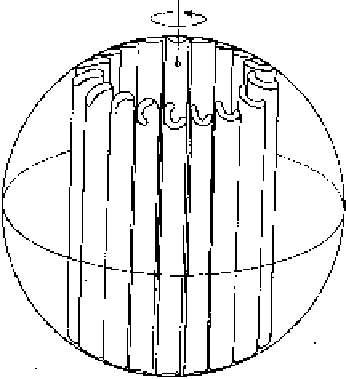Geoscience Reference
In-Depth Information
Figure 8.25.
Convection currents in a laboratory model of the
outer core, a rotating sphere containing a concentric liquid
shell and an interior sphere. Thermal convection in the fluid
was produced by maintaining a temperature difference
between the inner and outer spheres. The convection cells
which resulted were slowly spinning rolls; those in the northern
and southern hemispheres had opposite polarity. Such a
convection system in an electrically conductive outer core
would be capable of generating the Earth's dipole field. These
convection rolls drift in the same direction as the rotation
(arrow). (From Gubbins (1984).)
reinforces the original field. So, when the disc rotates fast enough, the system is
self-sustaining, producing its own magnetic field. Unlike a bicycle dynamo, which
has a permanent magnet, this dynamo does not need a large constant magnetic
field to operate; a slight transient magnetic field can be amplified by the dynamo.
All that is necessary is for the disc to be rotating. For this reason this model is
often called a self-exciting dynamo. The input of energy to power the dynamo is
that required to drive the disc.
An interesting feature of the dynamo shown in Fig. 8.24(c) is that it works either
with the current and field as illustrated or with both reversed. This means that, like
the Earth's dynamo, such a dynamo is capable of producing a reversed magnetic
field. However, unlike the Earth's dynamo, the dynamo in Fig. 8.24(c) cannot
reverse itself unless the circuit includes a shunt. It is most unlikely that the Earth's
dynamo is like this self-exciting disc dynamo. To start with, because the disc
dynamo has a hole in it and is antisymmetrical, it is topologically different from
the core. Also, it is hard to imagine that such a simple electrical-current system
could operate in the core without short-circuiting itself somewhere. Nevertheless,
it has been demonstrated that there are fluid motions in the liquid outer core that
can generate a magnetic field that can undergo random reversals.
The whole subject of magnetic fields in fluids is known as
magnetohydrody-
namics
. The mathematical equations governing fluid motion in the outer core and
generation of a magnetic field are a very complex interrelated set of non-linear
partial differential equations. They can, however, be separated (Jacobs 1987) into
four groups:
(a) the electromagnetic equations relating the magnetic field to the velocity of the fluid
in the outer core;

